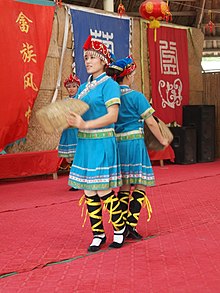 She traditional dance performance in Huanglongyan (黄龙岩), Heyuan, Guangdong | |
| Total population | |
|---|---|
| 709,592 (2000) | |
| Regions with significant populations | |
| Languages | |
| Predominantly She Chinese and Standard Chinese (lingua franca). A minuscule minority speak the She language in Zengcheng, Boluo County, Huidong County and Haifeng County in Guangdong Province. | |
| Religion | |
| She indigenous religion (She Wuism),[1] Buddhism | |
| Related ethnic groups | |
| Yao, Miao, Hakka Han |
| She people | |||||||||||||||||||||||||
|---|---|---|---|---|---|---|---|---|---|---|---|---|---|---|---|---|---|---|---|---|---|---|---|---|---|
| Chinese | 畲族 | ||||||||||||||||||||||||
| |||||||||||||||||||||||||
The She people (Chinese: 畲; She Chinese: [sa˦]; Cantonese: [sɛː˩], Fuzhou: [sia˥]) are an ethnic group in China. They form one of the 56 ethnic groups officially recognized by the People's Republic of China.
The She are the largest ethnic minority in Fujian, Zhejiang, and Jiangxi Provinces. They are also present in the provinces of Anhui and Guangdong. Some descendants of the She also exist amongst the Hakka minority in Taiwan.
Today, over 400,000 She people of Fujian, Zhejiang, and Jiangxi provinces speak She Chinese, an unclassified Chinese variety that has been heavily influenced by Hakka Chinese.
There are approximately 1,200 She people in Guangdong province who speak a Hmong–Mien language called She, also called Ho Ne meaning "mountain people" (Chinese: 活聂; pinyin: huóniè). Some said they were descendants of Dongyi, Nanman or Yue peoples.[2][3]
She Chinese (畲话) should not be confused with Shēyǔ (畲语), also known as Ho Ne, which is a Hmong-Mien language spoken in east-central Guangdong. She and Sheyu speakers have separate histories and identities, although both are officially classified by the Chinese government as She people. The Dongjia of Majiang County, Guizhou are also officially classified as She people, but speak a Western Hmongic language closely related to Chong'anjiang Miao (重安江苗语).
The She people are some of the earliest known settlers of Guangdong; they are thought to have originally settled along the shallow shore for easier fishing access during the Neolithic era. Eventually, after an influx of Yuet people moved south during the Warring States period, serious competition between the two peoples for resources developed.
From the time of the Qin dynasty on, waves of migrants from northern China have had a serious impact on the She people. Because they possessed superior tools and technology, these migrants were able to displace the She and occupy the better land for farming. As a result of this, some of the She were forced to relocate into the hilly areas of the Jiangxi and Fujian provinces.
Following this relocation, the She people became hillside farmers. Their methods of farming included burning grasses on the slope, casting rice seeds on those embers and then harvesting the produce following the growth season. Some of the She people also participated in the production and trade of salt, obtained from the evaporation of local pools of salt water.
Many conflicts took place between the Han Chinese and She peoples. For example, in one incident, She salt producers on Lantau Island in Hong Kong attacked the city of Canton in a revolt during the Song dynasty.
During the Ming-Qing dynasties they moved into and settled Zhejiang's southern region and mountain districts in the Lower Yangtze region, after they left their homeland in Northern Fujian. It is theorized that the She were pushed out of their land by the Hakka, which caused them to move into Zhejiang.[4]


ShunChang County
Dehua County


The roughly 45,000 She living in Guizhou Province form a separate subgroup, the Dongjia (东家人; Dōngjiā Rén), who differ notably in culture from the She in other areas.[6]
In a 2000 census, 709,592 She have been counted in China.
| Administrative division | Number of She | Percentage of all She in China |
|---|---|---|
| Fujian | 375,193 | 52.87% |
| Zhejiang | 170,993 | 24.1% |
| Jiangxi | 77,650 | 10.94% |
| Guizhou | 44,926 | 6.33% |
| Guangdong | 28,053 | 3.95% |
| Hunan | 2,891 | 0.41% |
| Hubei | 2.523 | 0.36% |
| Anhui | 1,563 | 0.22% |
| Other Provinces | 5,800 | 0.82% |
Only values of 0.5% and greater have been considered.